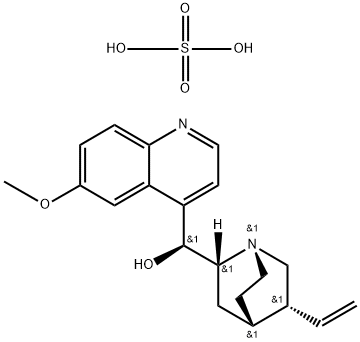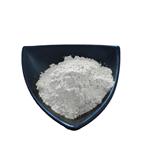Quinidine sulfate dihydrate is a diastereomer of quinine and a Na+ channel blocker. Also a class I antiarrhythmic drug. Quinidine sulfate dihydrate is a white, odorless crystalline substance that has a bitter flavor. It has limited solubility in water and alcohol but dissolves easily in chloroform and ether. This compound is effective against bacteria resistant to erythromycin, including staphylococci and streptococci, and works by inhibiting cellular ATPases.
Quinidine sulfate dihydrate is white to light yellow crystal powde
antiarrhythmic, antimalarial
Quinidine sulfate dihydrate (cas# 6591-63-5) is the hydrated, sulfate salt of Quinidine (Q685000), a dextrorotatory stereoisomer of Quinine. Antiarrhythmic (class IA). Antimalarial.
Quinidine sulfate salt dihydrate has been used as an antiarrhythmic drug to study its effects on phosphorylation and mutations in the cardiac sodium channel Nav1.5.
Cin-Quin (Solvay Pharmaceuticals); Quinidex (Wyeth); Quinora (Schering).
Quinidine sulfate dihydrate is the sulfateof an alkaloid obtained from various species ofCinchona and their hybrids. It is a dextrorotatory diastereoisomerof quinine. The salt crystallizes from wateras the dihydrate, in the form of fine, needlelike, white crystals.Quinidine sulfate contains a hydroxymethyl groupthat serves as a link between a quinoline ring and a quinuclidinemoiety. The structure contains two basic nitrogens,of which the quinuclidine nitrogen is the stronger base(pKa 10). Quinidine sulfate dihydrate is bitter and light sensitive.Quinidine sulfate dihydrates are nearly neutral or slightly alkaline. Itis soluble to the extent of 1% in water and more highly solublein alcohol or chloroform.
Quinidine sulfate dihydrate is acutely toxic and photosensitising. The photosensitisation reaction to quinidine sulphate was reproducible in the photopic test and after oral administration plus ultraviolet A (UVA) irradiation. Eczematous dermatitis was induced after intradermal injection of quinidine sulfate dihydrate irradiated by UVA in vitro only in the presence of the patient's serum. Three workers exposed to quinidine sulphate developed allergic reactions within a short period of time (2-3 months).
Class IA antiarrhythmic; potassium channel blocker.
Quinidine sulfate is the prototype of antiarrhythmicdrugs and a class IA antiarrhythmic agent according to theVaughan Williams classification. It reduces Na+ current bybinding the open ion channels (i.e., state A). The decreasedNa+entry into the myocardial cell depresses phase 4 diastolicdepolarization and shifts the intracellular threshold potentialtoward zero. These combined actions diminish thespontaneous frequency of pacemaker tissues, depress theautomaticity of ectopic foci, and, to a lesser extent, reduceimpulse formation in the SA node. This last action results inbradycardia. During the spike action potential, quinidinesulfate decreases transmembrane permeability to passiveinflux of Na+, thus slowing the process of phase 0 depolarization,which decreases conduction velocity. This is shownas a prolongation of the QRS complex of electrocardiograms.Quinidine sulfate also prolongs action potential duration,which results in a proportionate increase in the QTinterval. It is used to treat supraventricular and ventricularectopic arrhythmias, such as atrial and ventricular prematurebeats, atrial and ventricular tachycardia, atrial flutter, andatrial fibrillation.


